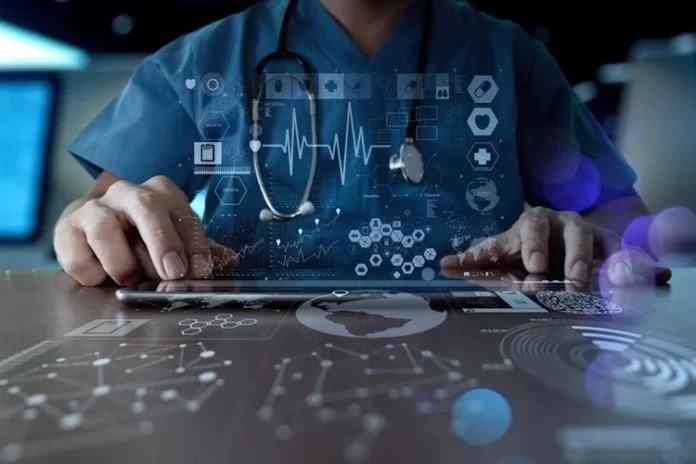With the massive fusion between medicine and technology, the benefits came to the benefit of both the patient and the phyisician alike.
The patient now receives a medical and diagnostic service in less time and with high accuracy, with the possibility of comparing and comparing results and treatments.
As for the physician, today he is able to view the patient’s file and medical history and review that data at any time with the possibility of comparing it with other patients.
All this is through the adopted EMR / EHR systems and solutions in hospitals and medical centers.
Many first-world countries have achieved great success in their hospitals at the level of applying electronic health record systems (EHR) and programs after realizing their importance in terms of developing the health care provided, as they are no less important than any other medical or therapeutic achievement.
The electronic medical record is the main source of information that the physician relies on in making various medical decisions.
The emergence and widespread of interoperable software and systems for electronic medical records facilitated the work of physicians and nurses in hospitals and medical centers and also contributed to providing better and more comprehensive patient care.
In fact, information technology in the health sector (Healthcare IT) has opened up huge potential through advanced software for electronic medical records.
These systems have been organized to facilitate the physician’s work and provide complete electronic monitoring, so that the electronic health records have become a center of strength in helping the physician to perform his work better through the medical information it provides to the patient in an integrated and coherent form; Perhaps its importance lies in the fact that it is linked with hospital information systems and its various services, such as laboratories, radiology, pharmacy, and others.
Implementation of such systems in healthcare facilities reduces errors much less than paper records, and improves communication between doctors significantly, allowing each party to have full access to the patient’s medical history instead of a quick look during the patient’s visit to the clinic.
Electronic medical records give the doctor the ability to accurately document all steps of patient care and provide complete and central electronic monitoring, whether by the patient or remotely through programs that provide leading software solutions.
But in this field, we must differentiate between the electronic medical record and the electronic health record.
What Is The Difference Between EMR & EHR?
The Electronic Medical Records (EMR) is an electronic system for keeping all the patient’s personal and medical information, including his medical and medical history, laboratory tests, radiology, and prescriptions, In addition to all medical services provided to the patient since the establishment of the registry.
This system is implemented in one hospital and information cannot be exchanged with any other medical facility.
The Electronic Health Records (EHR) connect several independent healthcare facilities, whether inside or outside the hospital. Thus, patient information is available at the sector or country level.
Planning For a Sustainable EMR Platform
When designing the automated information system, the degree of growth in the hospital’s size in the future and the changes that may occur in the information in terms of quantity and type must be taken into consideration.
It is necessary to study the economic feasibility of the system before its application and to ensure the availability of the material and human capabilities necessary to sustain it.
The administration must develop an integrated plan to shift from paper records to automated and electronic records, through a clear action plan for everyone who works on and uses this system.
What Does a Personal Electronic Medical Record contain?
Each patient’s medical record contains medical and nursing information covering aspects related to the condition he suffers from, and usually includes symptoms, medical history, results of clinical and diagnostic examinations, final diagnosis, pathological condition, medical, surgical and treatment procedures that the patient has undergone, the progress of the patient’s condition and response to these interventions and treatments, as well as information Identification of the patient.
In addition, there are general information that should be available to the attending physician when determining the treatment protocol, namely:
– Chronic diseases or health problems that the patient suffers from.
– Medications he is taking or any other type of treatment.
– Having an allergy to a particular drug.
– Previous surgeries he underwent with their dates, the name of the doctor and a report that includes the diagnosis of the condition that necessitated the operation.
– The results of laboratory tests and diagnostic images made by the patient.
– Family medical history in case of chronic diseases or cancerous conditions and others.
– Vaccines and their dates.
– Previous visits to the patient, what is the diagnosis, and the date and reason for each visit.
Read Also
- The Benefits of Contract Labor Staffing in HealthcareThe most successful healthcare facilities today aren’t just reacting to crises—they are building workforce resilience to withstand them. Unpredictable patient demand, coupled with persistent nursing shortages, has made the traditional staffing model obsolete. Relying on mandatory overtime to cover a sudden surge in capacity is a recipe for high turnover and rising employee burnout relief… Read more: The Benefits of Contract Labor Staffing in Healthcare
- Management Reinforcement for Healthcare Providers in a Shifting SystemHealthcare is changing faster than ever. So, providers are feeling the pressure to keep up. New technology, changing patient needs, and constant rule updates make it tough for managers to stay on top. Strong leadership helps teams work better, give great care, and stay happy in their jobs. Here’s how healthcare leaders can strengthen their… Read more: Management Reinforcement for Healthcare Providers in a Shifting System
- Why Effective Disinfection Remains the Foundation of Public HealthFrom hospitals and schools to transport hubs and food production sites, disinfection is central to breaking the chain of infection and protecting community health. The COVID-19 pandemic highlighted how crucial surface hygiene and environmental control are in reducing the spread of harmful microorganisms. Yet, beyond emergency response, routine and validated disinfection practices remain the cornerstone… Read more: Why Effective Disinfection Remains the Foundation of Public Health
- How to Navigate Your Medical Assistant Career PathBecoming a medical assistant can feel both exciting and a little stressful. This job lets you work closely with doctors and other healthcare workers to help patients. But with so many different paths to take, it can be hard to know where to start or how to plan your career. Wouldn’t it be nice to… Read more: How to Navigate Your Medical Assistant Career Path
- Benefits of Enrolling in Botox Training CoursesMany people want to enhance their skills in the beauty field, and one way to do that is through Botox training. With the rising popularity of Botox, enrolling in training courses can set you on a path to a rewarding career. If you are considering this option, you might be curious about the benefits that… Read more: Benefits of Enrolling in Botox Training Courses
Benefits of Electronic Medical Records to Physicians & Patients
Real-time Access to Patient Data
The most important benefit of electronic records is quick access to patient information with private notes on the condition and the ability to share it with other doctors, health care providers, insurance companies, pharmacies and diagnostic centers, so that that information becomes faster and more traceable.
Doctors can reach an accurate diagnosis more quickly by easily viewing the patient’s test results and checking past results or any medical practices the patient had previously.
Better Diagnostic Precision & Making Informed Decisions
The use of electronic records allows health care providers to simultaneously access a patient’s record from any computer. An electronic record can provide up-to-date information on a patient’s complete medical history, including results of current examinations and recommendations of other physicians, allowing for more effective collaboration across multiple aspects of patient care. Medical practitioners can also quickly transfer patient data to other departments or providers, while reducing errors and improving outcomes management.
Improved Patient Experience
These records ensure that the patient gets a better diagnosis with a very low error rate, as the patient gets advice and preventive measures that contribute to improving the management of his disease. This flexibility in accessing a patient’s complete records means that you do not have to fill out the same paperwork and data at every visit to the doctor because the results and images are all in one place. The result is better management of disease states, especially chronic conditions, better care and more accurate diagnosis.
Efficient Hospital Management
The benefit of electronic medical records is not limited to the doctor and the patient, but the hospital administration is one of the most beneficiaries due to the time, effort and costs needed by administrative tasks, as the various parties in any health facility spend a long time filling out paper forms for each patient. But electronic records are paperless, which has simplified routine tasks, and with the decrease in the amount of papers, there is no need for large areas for storage; With instant storage and retrieval of digital files, health care provider offices are less crowded.
Improved Healthcare Service Quality
Electronic medical records provide the ability to exchange complete information about the patient in record time, which is accurate, up-to-date and comprehensive, which naturally leads to raising the level of quality of care that the patient receives, from diagnosis to reduced errors. By sending automatic reminders for visits and preventative actions, patient records can help better manage their conditions and get more involved in health care. E-prescriptions also allow physicians to communicate directly with the pharmacy, reducing errors and saving time by eliminating lost prescriptions. Patient safety has been improved, as electronic prescriptions automatically check for potential drug interactions.
Increase Efficiency and Productivity
Electronic health records are more efficient than paper records because they allow quick access to the patient’s file and obtain information related to it that health care providers need in record time and from anywhere, in addition to the possibility of inquiring about a specific case with other doctors, pharmacies and diagnostic centers, which is a faster way More traceable, it also reduces missed messages and follow-up calls. Simplifying electronic file and records management, integrated scheduling between the various stakeholders, and automated encryption are all advantages that increase efficiency and increase productivity.






